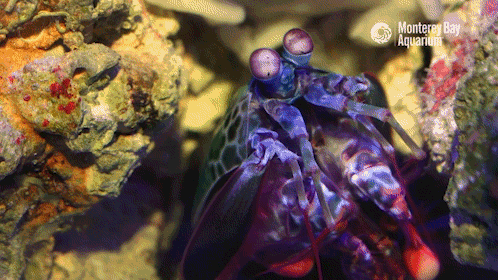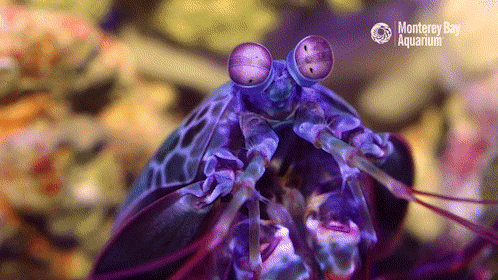If You Have Eyes For Just One Shrimp, Make It A Mantis Shrimp.






If you have eyes for just one shrimp, make it a mantis shrimp.
More Posts from In-pursuit-of-knowledge-blog and Others
10 Things: Journey to the Center of Mars
May the fifth be with you because history is about to be made: As early as May 5, 2018, we’re set to launch Mars InSight, the very first mission to study the deep interior of Mars. We’ve been roaming the surface of Mars for a while now, but when InSight lands on Nov. 26, 2018, we’re going in for a deeper look. Below, 10 things to know as we head to the heart of Mars.

Coverage of prelaunch and launch activities begins Thursday, May 3, on NASA Television and our homepage.
1. What’s in a name?

“Insight” is to see the inner nature of something, and the InSight lander—a.k.a. Interior Exploration using Seismic Investigations, Geodesy and Heat Transport—will do just that. InSight will take the “vital signs” of Mars: its pulse (seismology), temperature (heat flow) and reflexes (radio science). It will be the first thorough check-up since the planet formed 4.5 billion years ago.
2. Marsquakes.
You read that right: earthquakes, except on Mars. Scientists have seen a lot of evidence suggesting Mars has quakes, and InSight will try to detect marsquakes for the first time. By studying how seismic waves pass through the different layers of the planet (the crust, mantle and core), scientists can deduce the depths of these layers and what they’re made of. In this way, seismology is like taking an X-ray of the interior of Mars.
Want to know more? Check out this one-minute video.
3. More than Mars.

InSight is a Mars mission, but it’s also so much more than that. By studying the deep interior of Mars, we hope to learn how other rocky planets form. Earth and Mars were molded from the same primordial stuff more than 4.5 billion years ago, but then became quite different. Why didn’t they share the same fate? When it comes to rocky planets, we’ve only studied one in great detail: Earth. By comparing Earth’s interior to that of Mars, InSight’s team hopes to better understand our solar system. What they learn might even aid the search for Earth-like planets outside our solar system, narrowing down which ones might be able to support life.
4. Robot testing.
InSight looks a bit like an oversized crane game: When it lands on Mars this November, its robotic arm will be used to grasp and move objects on another planet for the first time. And like any crane game, practice makes it easier to capture the prize.
Want to see what a Mars robot test lab is like? Take a 360 tour.
5. The gang’s all here.

InSight will be traveling with a number of instruments, from cameras and antennas to the heat flow probe. Get up close and personal with each one in our instrument profiles.
6. Trifecta.

InSight has three major parts that make up the spacecraft: Cruise Stage; Entry, Descent, and Landing System; and the Lander. Find out what each one does here.
7. Solar wings.
Mars has weak sunlight because of its long distance from the Sun and a dusty, thin atmosphere. So InSight’s fan-like solar panels were specially designed to power InSight in this environment for at least one Martian year, or two Earth years.
8. Clues in the crust.

Our scientists have found evidence that Mars’ crust is not as dense as previously thought, a clue that could help researchers better understand the Red Planet’s interior structure and evolution. “The crust is the end-result of everything that happened during a planet’s history, so a lower density could have important implications about Mars’ formation and evolution,” said Sander Goossens of our Goddard Space Flight Center in Greenbelt, Maryland.
9. Passengers.

InSight won’t be flying solo—it will have two microchips on board inscribed with more than 2.4 million names submitted by the public. “It’s a fun way for the public to feel personally invested in the mission,” said Bruce Banerdt of our Jet Propulsion Laboratory, the mission’s principal investigator. “We’re happy to have them along for the ride.”
10. Tiny CubeSats, huge firsts.

The rocket that will loft InSight beyond Earth will also launch a separate NASA technology experiment: two mini-spacecraft called Mars Cube One, or MarCO. These suitcase-sized CubeSats will fly on their own path to Mars behindInSight. Their goal is to test new miniaturized deep space communication equipment and, if the MarCOs make it to Mars, may relay back InSight data as it enters the Martian atmosphere and lands. This will be a first test of miniaturized CubeSat technology at another planet, which researchers hope can offer new capabilities to future missions.
Check out the full version of ‘Solar System: 10 Thing to Know This Week’ HERE.
Make sure to follow us on Tumblr for your regular dose of space: http://nasa.tumblr.com.
Sometimes you have to lick the equipment for science. It’s just a little fluid ¯\_(ツ)_/¯

i was looking for info on when artificial sweeteners became popular and came across this. this idiot fuckn scientist just went and licked his entire lab. what a fuckign fool. wht the fuck
creativelibra: Is the feeling of love really just a chemical reaction in your head?
I’ll have to look into that next time I’m near Lantern!
just woke up from one hell of a nightmare i need a distraction…

This slender-snouted crocodile skull in Carnegie Museum of Natural History’s Alcohol House was used to determine that each African region had a unique crocodile species. You can see this skull and its story on display at the new We Are Nature. Look for the Alcohol House media interactive in the gallery!
This post was originally posted on our curatorial assistant’s Instagram, which features specimens in the museum’s historic Alcohol House.
What we all need to understand about AI in a nutshell:
There’s an algorithm that can reliably predict, from aggregate facebook posts, the onset of a manic episode in a person suffering from bipolar disorder – more reliably even, than a trained psychotherapist, who only has access to the information a patient provides them in therapy sessions.
“Won’t technology like that help people with bipolar disorder?”
Theoretically, it could. But this algorithm wasn’t designed to help people with bipolar disorder.
This algorithm was designed to sell plane tickets to Las Vegas.
[source]
-
 evb67 liked this · 2 months ago
evb67 liked this · 2 months ago -
 eclectichellmouth reblogged this · 2 months ago
eclectichellmouth reblogged this · 2 months ago -
 rainbowshrike reblogged this · 1 year ago
rainbowshrike reblogged this · 1 year ago -
 thelurkingmole reblogged this · 1 year ago
thelurkingmole reblogged this · 1 year ago -
 queerkataguiri liked this · 1 year ago
queerkataguiri liked this · 1 year ago -
 ffeneleargasast liked this · 1 year ago
ffeneleargasast liked this · 1 year ago -
 legendaryhologramavenue reblogged this · 1 year ago
legendaryhologramavenue reblogged this · 1 year ago -
 scicrab liked this · 1 year ago
scicrab liked this · 1 year ago -
 sunny-moth liked this · 1 year ago
sunny-moth liked this · 1 year ago -
 comrade-slugcat reblogged this · 1 year ago
comrade-slugcat reblogged this · 1 year ago -
 learnthehelloutathis liked this · 1 year ago
learnthehelloutathis liked this · 1 year ago -
 rainbowshrike reblogged this · 1 year ago
rainbowshrike reblogged this · 1 year ago -
 maggiefromspace reblogged this · 2 years ago
maggiefromspace reblogged this · 2 years ago -
 rainbowshrike reblogged this · 2 years ago
rainbowshrike reblogged this · 2 years ago -
 spiritualscientist9 liked this · 2 years ago
spiritualscientist9 liked this · 2 years ago -
 soveraaaans-bored reblogged this · 2 years ago
soveraaaans-bored reblogged this · 2 years ago -
 soveraaaans-bored liked this · 2 years ago
soveraaaans-bored liked this · 2 years ago -
 nosylla1011 reblogged this · 2 years ago
nosylla1011 reblogged this · 2 years ago -
 nosylla1011 liked this · 2 years ago
nosylla1011 liked this · 2 years ago -
 logicheartsoul liked this · 2 years ago
logicheartsoul liked this · 2 years ago -
 theanishimori reblogged this · 2 years ago
theanishimori reblogged this · 2 years ago -
 mixedupmojo liked this · 2 years ago
mixedupmojo liked this · 2 years ago -
 elskean liked this · 2 years ago
elskean liked this · 2 years ago -
 dizzypossum liked this · 2 years ago
dizzypossum liked this · 2 years ago -
 corruptspaghetti liked this · 2 years ago
corruptspaghetti liked this · 2 years ago -
 8ug8ear liked this · 2 years ago
8ug8ear liked this · 2 years ago -
 luffik reblogged this · 2 years ago
luffik reblogged this · 2 years ago -
 luffik liked this · 2 years ago
luffik liked this · 2 years ago -
 theshyghost reblogged this · 2 years ago
theshyghost reblogged this · 2 years ago -
 theshyghost liked this · 2 years ago
theshyghost liked this · 2 years ago -
 godsfavoritepastaboi reblogged this · 2 years ago
godsfavoritepastaboi reblogged this · 2 years ago -
 alfys-pigeon-house liked this · 2 years ago
alfys-pigeon-house liked this · 2 years ago -
 geeai reblogged this · 2 years ago
geeai reblogged this · 2 years ago -
 bucketofcowboys liked this · 2 years ago
bucketofcowboys liked this · 2 years ago -
 salbeitraeume reblogged this · 2 years ago
salbeitraeume reblogged this · 2 years ago -
 shoelasses19068 liked this · 2 years ago
shoelasses19068 liked this · 2 years ago -
 kinokochouchou liked this · 2 years ago
kinokochouchou liked this · 2 years ago -
 linottestridente liked this · 2 years ago
linottestridente liked this · 2 years ago -
 crowleys-angels reblogged this · 2 years ago
crowleys-angels reblogged this · 2 years ago -
 crowleys-angels liked this · 2 years ago
crowleys-angels liked this · 2 years ago
Once I was made of stardust. Now I am made of flesh and I can experience our agreed-upon reality and said reality is exciting and beautiful and terrifying and full of interesting things to compile on a blog! / 27 / ENTP / they-them / Divination Wizard / B.E.y.O.N.D. department of Research and Development / scientist / science enthusiast / [fantasyd20 character]
162 posts

